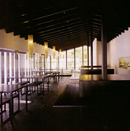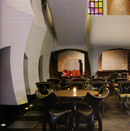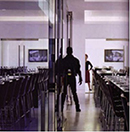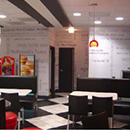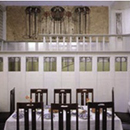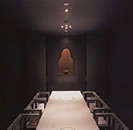
Black White
Black White describes an interior space that is limited to a black white palette for the floor, wall, ceiling planes and for furnishings. more
Black White | Restaurant
application
Black White in restaurant interiors refers to the extensive use of a black and white scheme, although in the 21st century, black is sometimes a dark chocolate. An accent color is sometimes achieved with lighting.
research
Historically Black White has been used cross-culturally in several periods and by various designers to produce high-contrast interiors, especially for restaurants.
Charles Rennie Mackintosh, a Scottish architect, designer, and artist, produced several black and white interiors. For the interior of his most important building, the Glasgow School of Art (1896-1909) Mackintosh used simple materials like timber and masonry constructional elements set off by unusual furniture and details of lighting and metalwork.1 Color is a very prominent feature in the interior spaces of the School. Most of the furniture is painted dark or black and the floors and ceilings are usually white. The combination of black and white, with Mackintosh’s geometric lines, make the interior spaces rectilinear, but with sensuous details. Mackintosh’s Tea Rooms are also good examples of the juxtaposition of black and white colors with delicate details.
The American decorator, Dorothy Draper, invented in 1923 what she called a “Modern-Baroque” style, fusing exaggerated ornament and vibrant, bright colors in never-before-seen combinations, such as aubergine and pink with a splash of chartreuse and a touch of turquoise blue. One of her favorite palettes was dull white and shiny black, a combination that became her signature, particularly for a harlequin floor. For the complete remodel of the Hampshire House apartment hotel on Central Park South in New York City, Draper added “bold 2-foot-square black and white marble floors, lavish wall reliefs and sconces that rendered the Baroque style of Grinling Gibbons in overscaled plaster and massive double doors surrounded by glass frames”. In designing the interiors of the Drake Hotel in Chicago, Draper added dramatic effects using the color scheme of camellia pink, green and black for finishes and furniture. Dining chairs were upholstered in white leather with fuchsia-colored veins, as if they were made of marble. Although Draper died in 1969, her firm, Dorothy Draper and Company, continues to draw on her color schemes. In 1991 the company executed a McDonald’s restaurant in Ontario, California using black and white for floor, wall and ceiling planes, as well as furniture.2
For the Restaurant Chikuyoutei (1989) in Tokyo, Izue Kan Architect and Associates employed a Black | White scheme in homage to the Sukiya style tea ceremony, a traditional Japanese architecture requiring minimal materials and colors. Kan transformed traditional elements into new shapes, introducing a westernized dining table and chairs in black and white. Wall and ceiling planes are finished with black and white industrialized construction materials. Black and dark grays substitute for the traditional use of a yellowish terra-cotta. White polished surfaces produce light reflections.3
Contemporary restaurants, such as Almerigo Hotel’s restaurant (2006) in Alicante, Spain, began as a preservation project. The designer, Elvira Blanco, was challenged to keep the historic interior and to also render it modern. Blanco preserved the original stone and ogival arches. She created a clean, minimalist interior environment of white marble and plastered walls contrasted with dark oak wood and leather, creating in effect a black and white restaurant.4
The designers of the Bluprint restaurant (2007) in Chicago executed a casual dining room and bar area in a dark and white palette using shiny and glossy materials—plastic laminate for tables and chairs, a corrugated glass partition and leather banquettes. Reflections from glass doors and partitions, as well as the polished surfaces of furniture, dramatize the color contrasts. Playing on the restaurant’s name, Bluprint, and its location in the Merchandize Mart, the accent color is cobalt blue.5
Lighting is an important factor when using two colors that have only values, but no hues. The color or intensity of lighting can turn into an inviting place or a threatening place. “Black or near-black walls close in on you like the night. They can suggest intimacy, enclosure, mystery, seduction, or may be considered threatening or depressing unless relieved by contrast of lost of windows. Whites with no transition ingredient to soften its impact or to relate it to other colors, to people, or to the environment, it is neutral, bold, assertive, and inclined toward coldness. At full strength pure white makes an extremely strong statement, and provides value contrast with other colors.”6
Limited colors of interior finishes and furnishings make lighting effects more dramatic. In recent years, due to the development of LED light and other advanced technologies, hundreds of different lighting solutions can be installed in restaurants. Restaurant Veil (2006) in Seattle, designed by Arai Jackson Ellison Murakami, is a dark and white space whose ceilings are treated a wash of pink gelled fluorescent lighting,7 the color scheme a contemporary take on Dorothy Draper.
Black White as a scheme for restaurant interiors emerges in the design trade magazines in the 1980 decade, and it has remained strong throughout the end of the 20th century. The image sequence illustrates reiterations of hard-edged industrial aesthetics, as well as historic preservation rehabilitation projects. In the 21st century Black | White has become lighter, the ratio of white is larger than black.8
end notes
- 1) John Pile, A History of Interior Design (Hoboken, N.J.: J. Wiley & Sons, 2005), 275.
- 2) Donald Albrecht, The High Style of Dorothy Draper: Exhibition Catalog of the Museum of the City of New York (New York: Museum of the City of New York and Pointed Leaf Press, 2006), 37, 38, 42, 60; Dorothy Draper & Company Inc., “Dorothy Draper,” Dorothy Draper Company Inc, http://www.dorothydraper.com/dd.htm.
- 3) Saitoh Hideo and Joao Rodolfo Stroeter, Interior Design in Cafes and Restaurants (Tokyo: Bijutsu Shuppansha, 1992), 32.
- 4) Stacy Shoemaker, “Divine Inspiration,” Hospitality Design 28, no. 1 (Jan./Feb. 2006): 64-69.
- 5) Bradley Lincoln, “Dining in Style,” Interior Design 78, no. 12 (Oct. 2007): 284-289.
- 6) Mary C. Miller, Color for Interior Architecture (New York: J. Wiley, 1997), 105-109.
- 7) John Peter Radulski, “Veil,” Architectural Record 194, no. 6 (June 2006): 310-312.
- 8) Evidence for the use and the chronological sequence of Black White as a restaurant archetype was developed from the following sources: 1900 Glasgow School of Art [1896-1909] Charles Rennie Mackintosh; Glasgow, Scotland in Wendy Kaplan, Charles Rennie Mackintosh (Glasgow: Glasgow Museums and New York: Abbeville Press, 1996), 160; PhotoCrd: Glasgow Museums / 1980 Geroge's [1980] Chicago Art and Architecture; Chicago, IL in Richard W. Planck, "Undulating Rhythm," Interior Design 51, no. 12 (Dec. 1980): 165; PhotoCrd: Anonymous; Remi [1987] Adam Tihany; New York City in Edie Lee Cohen, "Remi, New York," Interior Design 58, no. 10 (Oct. 1987): 291; PhotoCrd: Karl Francetic; Shin-A [1988] Suzuki; Tokyo, Japan in Jerry Cooper, "Shin-A," Interior Design 59, no. 4 (Apr. 1988): 222; PhotoCrd: Katsuaki Furudate / 1990 Legends [1990] Eva Jiricna; London, UK in Monica Geran, "Legends, London," Interior Design 61, no. 8 (Aug. 1990): 141; PhotoCrd: Richard Bryant; McDonald's restaurant [1991] Dorothy Draper and Company Inc.; Ontario, CA in Dorothy Draper and Company Inc., http://www.dorothydraper.com/dd.htm; Fressen [1999] Jed Johnson and Associates; New York City in Julie Lewis, "Healthy Glow," Interior Design 70, no. 11 (Sep. 1999): 209; PhotoCrd: John M. Hall / 2000 Temple [2001] Nardi Corsini Associates LLP/Architram Design Group; Beverly Hills, CA in Abby Bussel, "The Right Angle," Interior Design 72, no. 9 (July 2001): 175; PhotoCrd: David Gloms; Max Masa's [2002] Orlando Diaz-Azcuy; San Francisco, CA in Leslie Brenner, "Max Masa's," Interior Design 73, no. 3 (Mar. 2002): 178; PhotoCrd: David Duncan Livingston; Soba [2004] Kengo Kuma; Nagano, Japan in Clifford A. Pearson, "Soba Restaurant," Architectural Record 192, no. 4 (Apr. 2004): 149; PhotoCrd: Daici Ano; East Hotel Restaurant [2005] Jordan Mozer; Hamburg, Germany in Farhad Heydari, "East Hotel Restaurant," Architectural Record 193, no. 11 (Nov. 2005): 147; PhotoCrd: Doug Snower; Restaurant in Amerigo Hotel [2006] Elvira Blanco; Alicante, Spain in Stacy Shoemaker, "Divine Inspiration," Hospitality Design 28, no. 1 (Jan./Feb. 2006): 66; PhotoCrd: Hospes Hotel; Veil [2006] Arai Jackson Ellison Murakami; Seattle, WA in John Peter Radulski, "Veil," Architectural Record 194, no. 6 (June 2006): 310; PhotoCrd: Benjamin Benschneider; Stratus Vineyards [2007] Burdifilek, Toronto; Ontario, Canada in "Stratus Vineyards," Hospitality Design 29, no. 5 (May/June 2007): 119; PhotoCrd: Ben Rahn of A-Frame Inc.; Mart [2007] VOA Associates; Chicago, IL in Bradley Lincoln, "Dining in Style," Interior Design 78, no. 12 (Oct. 2007): 288; PhotoCrd: Nick Merrick, Hedrich Blessing; Blanc [2008] Meyer Davis Studio; New York City in Audrey Jaynes, "Open Restaurant Bar Blanc," Architects Newspaper 4, no. 3 (Mar. 2008): 5; PhotoCrd: Thomas Schauer.
bibliographic citations
1) The Interior Archetypes Research and Teaching Project, Cornell University, www.intypes.cornell.edu (accessed month & date, year).
2) Cho, Jasmin. “Theory Studies: Archetypical Practices of Contemporary Restaurant Design.” M.A. Thesis, Cornell University, 2009, 18-26.

